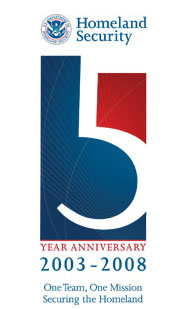
| Home | Information Sharing & Analysis | Prevention & Protection | Preparedness & Response | Research | Commerce & Trade | Travel Security & Procedures | Immigration |
| About the Department | Open for Business | Press Room |

The threat level in the airline sector is High or Orange. Read more.

Release Date: February 26, 2008
For Immediate Release
Office of the Press Secretary
Contact: 202-282-8010
(“US Curbs Big Plans for Border Tech Fence,” The Wall Street Journal, February 23, 2008)
The Wall Street Journal Inaccurately Asserts That First 28 Miles of the Virtual Fence Will Be the Last: "But The Problems That have plagued the high-tech barrier mean that the fence's first 28 miles will also likely be its last. The Department of Homeland Security now says it doesn't plan to replicate the Boeing Co. initiative anywhere else." ("US Curbs Big Plans for Border Tech Fence," The Wall Street Journal, February 23, 2008)
But, P28 was a proof of concept and a building block. It was never intended to be replicated across the entire border: “Let me remind everybody, of course, the border is not just a uniform place. It is a very complicated mix of different kinds of environments -- ranging from urban areas, where the distance between the border and a major transportation hub is measured in maybe less than a mile, to very remote and desolate rural areas or wilderness areas, where there's really, frankly, quite a bit more distance to be covered and therefore a lot more flexibility in how and when you interdict those crossing the border. That's why SBI Net, as a critical element, has been designed to be a flexible tool. It is not a cookie cutter approach. What applies in one stretch of the border is not going to be what applies in another stretch. What will be common, however, is that all of the stretches and all of the tools will be integrated and bound together.” (Transcript of Press Briefing by Secretary Chertoff on the Awarding of the SBInet Contract, 9/21/06)
It's an out-of-the box concept: "I would say it is a partial model for the future. I think that it was a concept. We wanted to make sure that, A, there's the basic concept functionality work and, B, the thought was to give the contractor an opportunity to present something that essentially thought out of the box, that wasn't just a follow-on to the traditional way of doing business." (Senate Homeland Security and Governmental Affairs Committee Hearing on the Fiscal 2009 Budget for the Department of Homeland Security, 2/14/08)
And, we'll use more technologies at the border: "…by the end of this calendar year, we will be a 670 miles of barriers. Plus, we will have deployed 40 what we call mobile surveillance systems. That is ground-based radar. We will have our P-28 system, and begin to employ other camera-based and sensor-based systems…we will have substantially put either real or virtual fencing or barriers across the entire border." (Secretary Chertoff at a House Homeland Security Committee hearing on the Fiscal 2009 Budget for the Department of Homeland Security, 2/13/08)
The Wall Street Journal Claims That DHS Will Be Mothballing the Concept Behind the Virtual Fence: "The effective mothballing of the concept is a setback for the government's border-protection efforts, an embarrassment for politicians backing the idea of an electronic fence and a blow to Boeing, the project's designer." ("US Curbs Big Plans for Border Tech Fence," The Wall Street Journal, February 23, 2008)
But, that's wrong: Technology used for P28 will continue to be deployed along the border. In fact, the FY09 budget requests $775 million for SBI to continue the development and deployment of technology and tactical infrastructure on the border.
The Wall Street Journal Erroneously Reports That DHS Issued Boeing a New Contract to Fix the P28 Common Operating System: "In early December, the government said it was closing in on taking delivery. But that same month, the government gave Boeing another $64 million contract to fix the "common operating picture," which lets agents in vehicles see imagery from the towers' surveillance systems." ("US Curbs Big Plans for Border Tech Fence," The Wall Street Journal, February 23, 2008)
But, this contract was to develop the new Common Operational Picture and to enhance systems capabilities for future deployments as initially planned. ("DHS Moves Forward on Border Fencing and Technology Improvements", December 7, 2007)
This page was last reviewed/modified on February 26, 2008.